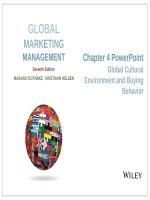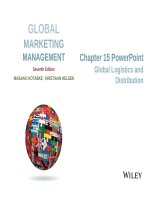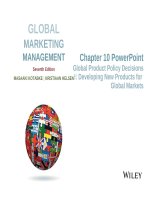Lecture Global marketing management (7th edition): Chapter 5 - Masaaki Kotabe, Kristiaan Helsen
Bạn đang xem bản rút gọn của tài liệu. Xem và tải ngay bản đầy đủ của tài liệu tại đây (5.21 MB, 27 trang )
GLOBAL
MARKETING
MANAGEMENT
Seventh Edition
MASAAKI KOTABKE | KRISTIAAN HELSEN
Chapter 5 PowerPoint
Political and Legal
Environment
Chapter Overview
1. Political Environment—Individual Governments
2. Political Environment—Social Pressures and
Political Risk
3. Terrorism and the World Economy
4. International Agreements
5. International Law and Local Legal Environment
6. Issues Transcending National Boundaries
Chapter 5
Copyright © 2017 John Wiley & Sons,
Inc.
2
Introduction
• International marketers should be aware that the
economic interests of their companies can differ
widely from those of the countries in which they do
business.
• International marketers must abide by various
international agreements, treaties, and laws.
• Political and legal climates are inherently related
and inseparable because laws are generally a
manifestation of a country’s political processes.
Chapter 5
Copyright © 2017 John Wiley & Sons,
Inc.
3
1. Political Environment—Individual
Governments
• Government affects almost every aspect of business
life in a country.
• National politics affect business environment
directly, through changes in policies, regulations,
and laws.
• The political stability and mood in a country affect
the actions a government will take.
• Home Country versus Host Country
Chapter 5
Copyright © 2017 John Wiley & Sons,
Inc.
4
1. Political Environment—Individual
Governments
•
Structure of Government
– Ideology
• Communism
• Capitalism
• Socialism
– Political Parties
• Single-party-dominant country
• Dual-party system
• Multiple-party system
•
Government Policies and Regulations
It is the role of government to promote a country’s interests in the
international arena for various reasons and objectives, such as:
national security, developing new industries, and protecting
declining industries.
Chapter 5
Copyright © 2017 John Wiley & Sons,
Inc.
5
1. Political Environment—Individual
Governments
-
Incentives and Government Programs
Government Procurement
Trade Laws
Embargoes and Sanctions
Tariff and Nontariff Barriers (Exhibit 5-1)
Export License Requirements
Investment Regulations (ownership and financial
controls)
- Macroeconomic Policies (governments’ monetary and
fiscal policies such as the cost of capital, level of
economic growth, rates of inflation and international
exchange rates) Copyright © 2017 John Wiley & Sons,
Chapter 5
Inc.
6
Exhibit 5-1:
Tariff and
Nontariff
Barriers
Chapter 5
Copyright © 2017 John Wiley & Sons,
Inc.
7
2. Political Environment—Social Pressures
and Political Risk
• Social Pressures and Special Interests
Foreign companies also have to consider social
factors as part of the political environment of host
countries, e.g., feelings of nationalistic interest.
• Managing the Political Environment
–
–
–
–
–
Chapter 5
Expropriation
Confiscation
Nationalization
Domestication Policy/Phase-Out Policy
Countertrade (See Exhibits 5-2 and 5-3.)
Copyright © 2017 John Wiley & Sons,
Inc.
8
Exhibit 5-2: Government Policy Areas
and Instruments
Chapter 5
Copyright © 2017 John Wiley & Sons,
Inc.
9
Exhibit 5-3: Country Risk Assessment
Criteria
Chapter 5
Copyright © 2017 John Wiley & Sons,
Inc.
10
Exhibit 5-4: Examples of Country Risk
Ratings Ranked by Composite Overall
Rating, Jan. 2015
Continued
Chapter 5
Copyright © 2017 John Wiley & Sons,
Inc.
11
Exhibit 5-4: Examples of Country Risk
Ratings Ranked by Composite Overall
Rating, Jan. 2015
Continued
Chapter 5
Copyright © 2017 John Wiley & Sons,
Inc.
12
Exhibit 5-4: Examples of Country Risk
Ratings Ranked by Composite Overall
Rating, Jan. 2015
Continued
Chapter 5
Copyright © 2017 John Wiley & Sons,
Inc.
13
Exhibit 5-4: Examples of Country Risk
Ratings Ranked by Composite Overall
Rating, Jan. 2015
Chapter 5
Copyright © 2017 John Wiley & Sons,
Inc.
14
3. Terrorism and the World Economy
• According to an IMF study, the September 11, 2001
terrorist attacks in New York and Washington D.C.
resulted in a direct loss of $21.4 billion.
• The short-term lost economic output was estimated
as $47 billion.
• The stock market lost $1.7 trillion.
• Terrorist activities and military skirmishes disrupt
international movement of supplies and
merchandise as well as international financial flow
and tourism.
Chapter 5
Copyright © 2017 John Wiley & Sons,
Inc.
15
4. International Agreements
• Group of Seven (G7) is an economic policy
coordination group made up of political leaders from
Canada, England, France, Germany, Italy, Japan,
and the United States.
• Group of Eight (G8) consists of G7 and Russia.
• Group of Twenty (G20) expanded G8 in 1999 to
bring industrialized and developing economies
together to promote economic growth and
international financial stability in the global economy
at the ministerial level.
• Wassenaar Arrangement was founded in 1995 as
Copyright
© 2017 John Wiley
& Sons,
a 5multilateral export
control
agreement
on
Chapter
16
Inc.
5. International Law and
Local Legal Environment
• International Law, or “the law of nations,” may be
defined as a body of rules that is binding on states
and other international persons in their mutual
relations. It comes from three main sources:
– Customs
– International treaties
– Court decisions
• Local Legal Systems and Laws
– Business Practices and the Legal System
Chapter 5
Copyright © 2017 John Wiley & Sons,
Inc.
17
Exhibit 5-6: Legal Issues Facing the
Company
Chapter 5
Copyright © 2017 John Wiley & Sons,
Inc.
18
5. International Law and
Local Legal Environments
– Regulations on E-Commerce
• Privacy Issues
– Types of Legal Systems
• Common Law
• Code (written) Law
• Islamic Law (Sharia)
– Examples of Different Laws
• Criminal Law
• Civil Law
• Commercial Law
Chapter 5
Copyright © 2017 John Wiley & Sons,
Inc.
19
5. International Law and
Local Legal Environments
– Cultural Values and Legal Systems
• Japan’s population of lawyers is low as legal
confrontations are very rare.
• In the U.S., emphasis is on explicit contracts and a
reliance on the legal system is high.
• In China, relationships (guanxi) and verbal contracts
are important.
• In Brazil, Jeitinho is used to find solutions outside the
legal contract on a case-by-case basis.
• Jurisdiction
– Planning Ahead
– Arbitration and Enforcement
Chapter 5
Copyright © 2017 John Wiley & Sons,
Inc.
20
Exhibit 5-7: The Number of Lawyers
per 100,000 Residents
Chapter 5
Copyright © 2017 John Wiley & Sons,
Inc.
21
6. Issues Transcending National Boundaries
• ISO 9000 certification has become an essential
marketing tool for firms.
• ISO 14000 is based on the principle of selfregulation, thereby minimizing surveillance and
sanctions by the EPA and its state-level
counterparts.
• Intellectual Property Protection
– TRIPS (Trade-Related Aspects of Intellectual Property
Rights)
– Patent (“first-to-file” and “first-to-invent” principles)
Chapter 5
Copyright © 2017 John Wiley & Sons,
Inc.
22
6. Issues Transcending National Boundaries
– Copyright
– The Digital Millennium Copyright Act (DMCA)
– Trademark (prior-use, first-to-use & first-to-file
principles)
– Trade Secret
• International Treaties for Intellectual Property
Protection
– Paris Convention
– Patent Cooperation Treaty (PCT)
– Patent Law Treaty (PLT) (See Exhibit 5-8.)
Chapter 5
Copyright © 2017 John Wiley & Sons,
Inc.
23
Exhibit 5-8: Top 60 Countries in Ratings for
the Level of Intellectual Property Protection
Chapter 5
Copyright © 2017 John Wiley & Sons,
Inc.
24
6. Issues Transcending National Boundaries
–
–
–
–
European Patent Convention
Berne Convention
WIPO Copyright Treaty
Anticounterfeiting Trade Agreement (ACTA)
• Antitrust Laws of the United States
–
–
–
–
–
Chapter 5
The Sherman Act
The Clayton Act
The Robinson-Patman Act
Extraterritorial application of U.S. antitrust laws
Export Trading Company legislation (ETC Act) of
1982
Copyright © 2017 John Wiley & Sons,
Inc.
25









